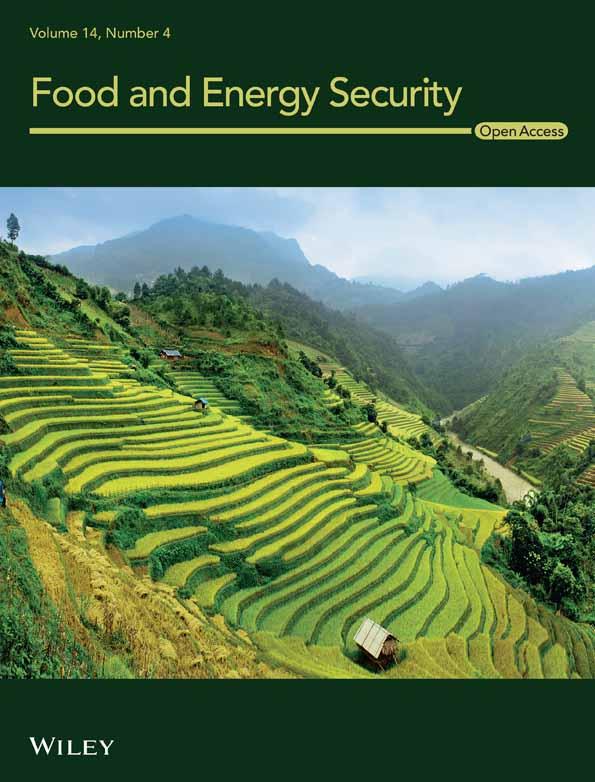Silicon Enhances Yield in Dry-Cultivated Rice/Soybean Intercropping Systems by Altering Root Morphology and Distribution
Funding: This work was financially supported by the National Natural Science Foundation of China (32301449), the Scientific Research Project of the Education Department of Jilin Province (JJKH20250564KJ) and the Jilin Science and Technology Development Plan Project (20240303024NC).
ABSTRACT
Intercropping cereals and legumes can increase agricultural productivity, but the effects of silicon (Si) fertilizer application on intercropped crop yield and interspecific root interactions in cereal/legume intercropping systems are unclear. Hence, field and pot experiments were conducted with dry-cultivated rice and soybean grown alone or intercropped under two Si levels (0 and 45 kg ha−1) to investigate the effects of Si application on the yield, root morphology, and distribution of dry-cultivated rice/soybean intercropping systems. The results revealed that the total yields of the intercropping and monoculture systems were 15% and 13% greater, respectively, under Si application (Si45) than under no Si addition (Si0). Compared with the yield under monoculture, the total yield under intercropping increased by 5% and 7% under Si0 and Si45, respectively. This overyielding leads to a land equivalent ratio > 1 under both Si levels. This increase was primarily due to a 24% increase in intercropped soybean yield, despite a 7% decrease in rice yield averaging the two Si levels. The crop yield was positively correlated with root morphological traits, and the root surface area was the most significant predictor of crop yield. Intercropped soybean demonstrated a competitive advantage over rice. Thus, the root morphology traits of soybean were promoted, whereas these parameters in rice were inhibited by intercropping. Compared with Si0, Si application significantly promoted the root morphology and distribution traits of both crops in the intercropping system. Overall, the application of Si during dry-cultivated rice/soybean intercropping significantly enhanced yield production by modifying the root morphology and distribution.
1 Introduction
Silicon (Si), the second most abundant element in the earth's crust (28.8%), has attracted increasing attention for its essential role in gramineous crops such as rice (Oryza sativa L.) and its positive impact on legume crops such as soybeans (Glycine max L.) (Tripathi et al. 2021; Huang et al. 2022). Intercropping, which has been recognized as an efficient agricultural production technique, can control pests and diseases while increasing crop yields efficiently via the use of natural resources such as fertilizer, soil nutrients, water, and light (Li et al. 2021). The application of Si fertilizer can further increase the benefits of intercropping (Ning et al. 2017). As a beneficial trace element for plants, Si can synergize with multiple soil nutrients, thereby increasing crop yields within intercropping systems (Ning et al. 2017; Shen et al. 2019). Several studies have shown that the addition of Si to soil not only improves crop yield and quality, but also enhances crop nutrient uptake (Ning et al. 2017; Jiang et al. 2023). For example, in rice–water spinach intercropping systems, an elevated Si concentration in rice leaves facilitates the transfer of nitrogen from leaves to ears, consequently increasing the grain-filling concentration and ultimately increasing the grain weight, yield, and quality of rice (Ning et al. 2017). Similarly, Si application can increase soil phosphorus and potassium availability in sugarcane–peanut intercropping systems, thereby increasing the yield of intercropped crops (Shen et al. 2019). However, most studies on Si application and intercropping have focused on aboveground plant parts. The root system plays a crucial role in regulating the acquisition of unevenly distributed belowground resources, and Si can positively influence these traits (Chung et al. 2020; Shohani et al. 2023). The application of Si increased root length and root diameter of wheat and soybean, respectively (Ashfaq et al. 2023; Tripathi et al. 2021). However, it remains largely unclear whether Si application to intercropping systems can change crop root morphology and improve yields in these systems.
Among intercropping combinations, cereal/legume intercropping has a long history. Currently, 70% of more than 100 interspecies combinations in China involve cereal/legume intercropping (Tang et al. 2021). The yield increases in these systems are partially due to belowground interspecific facilitation and complementarity (Li et al. 2021; Yang et al. 2022). Intercropped crops can absorb nutrients from different soil layers because of differences in root size, depth, and nutrient demand, thereby improving soil nutrient use efficiency (Ma et al. 2023). The root compatibility between intercropped legume and cereal species allows the roots of cereal species to spread below the roots of neighboring legumes, resulting in significantly greater root length density than that observed in monocultures (Zhang et al. 2014; Zheng et al. 2021). Moreover, the highly plastic root morphology modulated by the presence of neighboring plants in intercropping systems can increase soil exploitation, leading to improved water use efficiency and nutrient acquisition by cereal species compared with monocultures (Sun, Gao, Yang, et al. 2019). For example, maize (Zea mays L.)/soybean (Glycine max L.) intercropping increased crop yield through a significant increase in the root surface area and dry weight of both maize and soybean (Zhang et al. 2012). However, most cereal/legume intercropping systems are cereal-dominated, with combinations such as maize/chickpea (Cicer arietinum L.), maize/faba bean (Vicia faba L.), proso millet (Panicum miliaceum L.)/mung bean (Vigna radiata L.) and cowpea (Vigna unguiculata (Linn.) Walp.)/maize intercropping (Latati et al. 2014; Zhang et al. 2016; Gong et al. 2020). Moreover, studies on the relationships between intercropping and root morphology or root distribution have focused primarily on macronutrients (Trachsel et al. 2013; Yang et al. 2022). The effects of Si application on root morphology and distribution within cereal/legume intercropping systems remain largely unexplored and require further clarification.
The dry cultivation of rice is rapidly developing worldwide, supporting water-saving agriculture and simplified production measures (Jiang et al. 2022). However, rice yields are relatively low, making the intercropping of rice with leguminous crops a significant strategy for increasing productivity. This approach is vital for safeguarding food security and alleviating water shortages (Adekoya et al. 2014; Weller et al. 2016). The soybean, an important grain crop in Northeast China, is rich in plant protein and has a strong ability to fix nitrogen (Tripathi et al. 2021). In intercropping systems, nitrogen fixation and root activation of legume crops may promote nutrient uptake and utilization in intercropped cereals (Pang et al. 2018; Wang, Hou, et al. 2020). Therefore, it is highly important to reduce agricultural surface pollution for sustainable agriculture and explore whether Si fertilizer can increase rice yield with soybean intercropping.
In the present study, field and pot experiments involving dry-cultivated rice/soybean intercropping at two Si levels were conducted to (1) evaluate whether Si application can improve the yield and land productivity of dry-cultivated rice/soybean intercropping; (2) investigate whether changes in root morphology and distribution associated with Si application contribute to greater total yield; and (3) identify key root morphological traits that influence crop yield. We hypothesized that in dry-cultivated rice/soybean intercropping systems, Si application can improve crop yield and land productivity by altering the root morphology and distribution of intercropped crops.
2 Materials and Methods
2.1 Field Experiment
The field experiment was conducted in 2023 on meadow black soil at the Research Base of Jilin Agricultural University, Changchun, Jilin Province, Northeast China (43°81′ N and 125°40′ E, 238.6 m above sea level). This area has a humid continental climate, with an annual mean temperature of 7.8°C, an annual accumulated temperature (≥ 10°C) of 3676.8°C, and an annual precipitation of 465.8 mm, with most precipitation occurring between May and September (data from https://www.ncdc. noaa.gov/) (Figure S1). The annual frost-free period ranges from 135 to 140 days. The top 20 cm of soil was homogenous, with 26.8 g kg−1 organic C, 2.1 g kg−1 total N, 22.3 mg kg−1 Olsen-P, 148.7 mg kg−1 available K, and a pH of 6.95. The soil available Si content was 107.2 mg kg−1, indicating the medium Si supply capacity of the soil (Su et al. 2022).
The experiment was arranged in a split-plot design, with the Si treatments as the main plots and rice and soybean plants grown either in monoculture or intercropped as the subplots, with four replicates. The two Si treatments included no exogenous Si application (Si0) and Si fertilization (Russian mineral silica, CJSC Industrial Group ALSICO, Moscow, Russian, with an effective silica content of ≥ 72%) at a rate of 45 kg Si ha−1 (Si45), suitable for dry-cultivated rice in the central region of Jilin Province. The two cropping methods used here were as follows: (1) monocultured rice (MR) or soybean (MS) in 8 rows and (2) four rows of dry-cultivated rice intercropped with four rows of soybean, with a row spacing of 30 cm between the rice and soybean strips (Inter) (Figure S2). The area of each plot for monocultured dry cultivated rice and soybean was 2.4 × 6 m, whereas that of the intercropping plot was 7.20 × 6 m, with each intercropping plot having three belts. A 1 m wide walkway was set up between the plots to separate them from each other.
Rice (cv. Suijing No. 18) and soybean (cv. Jinong No. 89) were planted in early May 2023. The seeding rates were 150 kg ha−1 for rice and 200,000 plants ha−1 for soybean. In all the planting modes, rice was supplied with 160 kg N ha−1 urea (46% N), 60 kg P ha−1 calcium superphosphate (12% P) and 75 kg K ha−1 potassium chloride (60% K), whereas soybean was supplied with 75 kg N ha−1, 60 kg P ha−1 and 75 kg K ha−1. For the soybean, all the fertilizers were broadcast onto the soil surface at sowing as base fertilizer. For the rice, superphosphate and potash were broadcast onto the soil surface at sowing as the base fertilizer, Si fertilizer was broadcast at a 5:5 ratio onto the soil surface at sowing and at heading, and N fertilizer was applied at a ratio of 5:3:2 as the base fertilizer (at sowing), tiller fertilizer (at tillering) and spike fertilizer (at heading). Both rice and soybean were grown under rain-fed conditions throughout the growth period. Irrigation was applied when the soil water potential at a depth of 10–15 cm dropped below −35 kPa. A fixed spray 360° atomization rotating sprinkler system was used, with a spraying radius of 8 m and a water output of 0.7 m3 h−1. The dry-cultivated rice and soybean were irrigated for approximately 2 h each time, and the crops were irrigated twice during the growing season, after which the soil water potential reached −10 kPa. The soil water potential was monitored twice a week using a soil water potential meter (SYS-TSS1; Sayas Technology Co. Ltd., Liaoning, China). Weeds, diseases and pests were managed as needed during the growing season.
2.2 Pot Experiment
The pot experiment was conducted in a two-factor completely randomized arrangement with two Si levels (0 and 45 kg ha−1) and two root separation methods, namely complete root separation (RS) and no root separation (NS). PS treatment eliminates interspecific root interactions, whereas NS treatment allows for interspecific root promotion and competition; similar pot experiments have also been reported in other studies (Ning et al. 2022; Zhao et al. 2020). Air-dried soil (10 kg) was passed through a 2 mm sieve and placed into plastic pots (40 cm long, 20 cm wide, and 25 cm high). The soil collected from the top 20 cm in a field paddock near the field experiment at Jilin Agricultural University had 13.4 g kg−1 organic C, 1.5 g kg−1 total N, 28.0 mg kg−1 available P, 22.8 mg kg−1 available K, and a pH of 6.90. For the root separation treatment, each pot was cut into two sections, separated by solid material, and then reconstructed with polyvinyl chloride (PVC) adhesive (Figure S3). Each treatment had five replicates. Each side of the pot was planted with either rice or soybean in both root separation modes. The rice was planted at a depth of 2 cm with 5 seeds in one hole, while the soybeans were sown at a depth of 3 cm with 1 seed in each hole, and each pot had two holes of rice and soybean on each side, ensuring that each species occupied half of the pot and in keeping one hole of species in each pot at the seedling stage. Both crops were planted on May 4, 2023, following the same fertilizer application strategies as described in the field experiment.
2.3 Sampling and Analysis
2.3.1 Root Sampling and Root Parameter Measurements
The root samples of rice and soybean were taken at the full heading stage of rice (early August), when the soybean plants in the field were at the flowering stage. In monoculture systems, three representative individual rice or soybean plants were randomly sampled from the middle of each plot to avoid edge effects. In the intercropping plots, three representative individual plants of rice and soybean were randomly sampled from the first rows adjacent to another species. The sites of samples were randomly taken from the middle of each plot to avoid any side effects. To study the root morphology, a shovelomic method (Trachsel et al. 2011) was used to harvest the roots. Soil cubes measuring 30 × 30 cm and 30 cm were excavated from the field. Roots were obtained by washing the soil cubes with running water. From each set of three selected plants, one plant of representative size per row was selected for morphological measurements. For the pot experiments, the entire root systems of the rice and soybean plants were collected at the rice full heading stage (70 days after planting) for root morphological analysis (Figure S4).
In the field experiment, to investigate the root distribution along the soil profile at a later growth stage, an auger sampling method was employed to minimize plot disturbance. Soil cores (6 cm diameter) were collected from the top 10 cm and then at 10 cm intervals down to a maximum depth of 40 cm to determine the vertical root distributions along the soil profile (i.e., 0–10, 10–20, 20–30, and 30–40 cm). Soil cores were randomly taken from each plot, as shown in Figure S2, and they were placed in mesh bags with 0.2 mm mesh. The soil cores were soaked in water for at least 2 h to loosen the soil, and the roots were then carefully washed with running water. The roots of rice and soybean are distinguished on the basis of their root architecture, color, and texture: rice has fibrous roots that are smooth, whereas soybean has a taproot system with brown and significantly lignified roots. All the root samples used for morphology and distribution analysis were scanned using a flatbed scanner (Perfection V700 Photo; Epson America) at a resolution of 23.6 pixels mm−1 (600 dpi) and analyzed with the image-processing software WinRHIZO Pro (Regent Instruments, Québec, Canada) to determine the total root length, root surface area, and root volume of the root morphology samples. The roots were then oven-dried at 65°C for 72 h, after which the dry weight was recorded. For the root distribution samples, the root length was determined at each soil depth.
2.3.2 Crop Yield, Crop Biomass and Soil Nutrient Analysis
In the field, rice and soybean plants were harvested at maturity. In the monoculture system, evenly growing rice plants were randomly selected and clipped over a length of 3 m from the middle rows, whereas for the soybean plants, 20 continuous soybean plants were harvested, avoiding the side rows. In the intercropping system, rice or soybean plants from the first two rows adjacent to another intercropped crop were harvested from the middle of the intercropping plots. “Crop yield” referred specifically to the grain yield in the field. In the pot experiment, rice and soybean plants were harvested at the rice full heading stage (mid-July). All the aboveground samples of rice and soybean were dried at 65°C to a constant weight after the enzymatic activity was deactivated at 105°C for 30 min. The oven-dried samples were then ground using a ball mill (MM400, Retsch, Germany).
The soil pH was determined in a soil–water (1:2.5, w/v) slurry with a compound electrode (PE-10, Sartorius, Germany). The soil available N content was determined by the Kjeldahl method. The soil available phosphorus (P) content was measured colorimetrically at 882 nm using the molybdenum blue method. The soil available K content was determined in 1 M ammonium acetate extracts using flame photometry (FP640: INASA) (Allen et al. 1976).
2.4 Calculations
2.5 The Weighted Means of Si Uptake Were Calculated Using the Following Equation
2.6 Statistical Analysis
The normal distribution and homogeneity of variances for all the data were tested using the Shapiro–Wilk test with SPSS 22.0 software (SPSS Inc., Chicago, IL, USA). Image rendering was performed with Origin2021 (Northampton, Massachusetts, USA) and the R statistical software platform (version 4.0.3). Two-way ANOVA was used to evaluate the effects of the Si level and cropping pattern on the yield and biomass of rice and soybean, total yield and biomass, total root length, root surface area, root volume, root dry weight, root length density of rice and soybean, and pH, available N, Olsen-P, and available K in the soil. When the interactions were significant, one-way ANOVA was used to evaluate the effects of a single factor by fixing the other factor, and significant differences in means were compared using Duncan's multiple-comparison range test, with a significance level set at p < 0.05. One-way ANOVA was also used to evaluate the effects of the Si level on the partial land equivalent ratios of rice and soybean, the land equivalent ratio (LER), the complementarity effects (CE) of rice and soybean, and the competitive ratio (CRsr). Correlation analysis further revealed the associations between the yield, Si uptake, and root architecture and soil physicochemical properties in rice and soybean. Principal component analysis (PCA) was performed using Canoco software (Canoco for Windows 5.0) to illustrate the associations between the yields of rice and soybean and various variables, including the root morphological characteristics, pH, available N, Olsen-P, and available K in the soil.
3 Results
3.1 Crop Yield, Land Equivalent Ratio and Partial Land Equivalent Ratio in the Field
The total yield, rice yield, and soybean yield were significantly affected by the cropping pattern and Si level (Figure 1). Compared with Si0, Si application significantly increased the total yield and the rice and soybean yields by 13%, 18%, and 14%, respectively, when the average of the two cropping patterns was used (Figure 1). Specifically, the total yields of the intercropping and monoculture systems were 15% and 13% greater, respectively, under Si45 than under Si0. Compared with the corresponding monocultures, intercropping significantly reduced the rice yield by 7% while substantially increasing the intercropped soybean yield and total yield by 24% and 6%, respectively, taking an average of the two Si levels (Figure 1A–C). This result led to a partial land equivalent ratio (PLER) of the yield of < 0.5 for the intercropped rice and > 0.5 for the intercropped soybean (Figure 1D,E). There was a significant increase in the land equivalent ratio (LER) (1.09) of the intercropped rice/soybean system under both Si levels (Figure 1F).
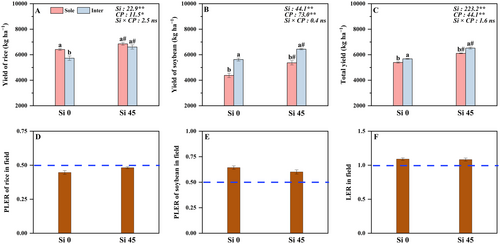
3.2 Crop Biomass in the Pot Experiment
The total biomass, rice biomass, and soybean biomass were significantly affected by the root separation mode and Si level (Figure 2). Compared with Si0, Si application significantly increased total biomass and rice and soybean biomass (Figure 2). Specifically, Si application increased the total biomass and the rice and soybean biomasses by 28%, 30%, and 26%, respectively, in the RS treatment and by 33%, 42%, and 27%, respectively, in the NS treatment relative to those in the Si0 treatment (Figure 2). Compared with that in RS, the rice biomass in NS decreased by 10%, whereas the soybean biomass in NS increased by 25%, which was the average of the two Si levels (Figure 2A,B). This increase also resulted in a greater PLER for soybean than for rice based on pot biomass at the two Si levels (Figure 2D,E). The total biomass in NS was 5% and 10% greater than that in RS at Si0 and Si1, respectively (Figure 2C). The total biomass in NS was 5% and 10% greater than that in RS at Si0 and Si1, respectively, which resulted in an LER of no root separation > 1 at the two Si levels (Figure 2F).
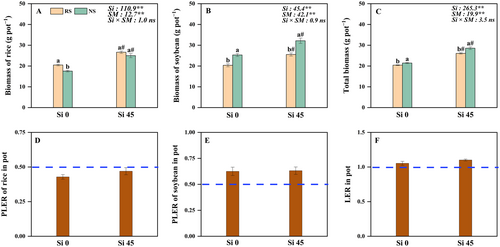
3.3 Competitive Ratio (CR) and Complementarity Effect (CE) in the Intercropping System in the Field
Regardless of the Si level, the CRsr of the intercropping systems was > 1, ranging from 1.2 to 1.5 (Figure 3A). As for CE, the CE based on yield was greater than zero in soybean and less than zero in rice at two Si levels (Figure 3B,C). Overall, soybean was more competitive than rice (Figure 3).

3.4 Morphological Traits of Rice and Soybean Roots in the Field and Pot Experiments
In the field, the total root length, root surface area, root volume, and root dry weight of rice and soybean were significantly affected by the Si level and cropping pattern (Figure 4). Compared with Si0, Si application significantly increased the total root length, root surface area, root volume, and root dry weight in the field by 29%, 14%, 29%, and 21% in rice and 25%, 21%, 21%, and 20% in soybean, respectively, across both cropping patterns, and the increase in these parameters in the monoculture system was greater than that in the intercropping system (Figure 4). Compared with monocultured rice, intercropping significantly reduced the total root length, root surface area, root volume, and root dry weight of rice in the field by 75%, 11%, 31%, and 24%, respectively, when the values were averaged across the two Si levels (Figure 4A–D). In contrast, intercropping significantly increased the total root length, root surface area, root volume, and root dry weight of soybean plants in the field by 40%, 18%, 69%, and 17%, respectively, compared with those of monocultured soybean plants; these values were averaged across the two Si levels (Figure 4E–H).

In the pots, the total root length, root surface area, root volume, and root dry weight of the rice and soybean plants were significantly affected by the Si level (Figure 5). Compared with Si0, Si application significantly increased the total root length, root surface area, root volume, and root dry weight of rice grown in pots by 45%, 35%, 38%, and 38%, respectively, across the two root separation modes and by 34%, 36%, 36%, and 34%, respectively, in soybean (Figure 5). Specifically, the root morphological traits in the intercropping and monoculture systems increased by 41% and 37% in rice and 36% and 34% in soybean, respectively, in response to Si application compared with those in response to the no Si0 treatment, and all the measured root parameters were averaged. The root separation mode also had significant effects on the root dry weight of the rice and on the total root length, root surface area, root volume, and root dry weight of the soybean plants in the pots (Figure 5). Compared with those in the RS treatment, the root dry weight of the rice in the NS treatment decreased by 15% (Figure 5D), whereas the total root length, root surface area, root volume, and root dry weight of the soybean in the NS treatment increased by 35%, 39%, 39%, and 29%, respectively, compared with those in the other treatments, with an average Si level (Figure 5E–H).
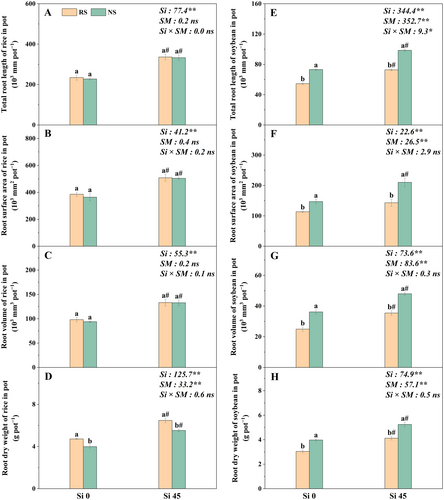
3.5 Spatial Distribution of the Root Length Density of Rice and Soybean in the Field
The roots of dry-cultivated rice in the field were distributed primarily in the 0–30 cm soil layer, whereas the roots of the soybean plants extended slightly deeper, with their roots distributed primarily in the 0–40 cm soil layer (Figure 6). Si application increased the total root length density (RLD) of both rice and soybeans in the 0–40 cm soil layer by 13% and 14%, respectively, in the monoculture system and by 13% and 11%, respectively, in the intercropping system (Figure 6). Compared with monoculture, intercropping reduced the RLD of rice by 14%, whereas it increased the RLD of soybeans by 12% in the 0–40 cm soil layer when the RLD was averaged across the two Si levels. This result led to a lower RLD for intercropped rice and a higher RLD for intercropped soybeans in the 0–40 cm soil layer than for monocultures (Figure 6). Specifically, more than 90% of the rice and soybean roots were distributed in the topsoil (0–20 cm soil layer) (Figure 6). The RLDs of rice and soybeans in the 0–20 cm soil layer were significantly affected by both the Si level and cropping pattern (Table S1). Compared with Si0, Si application significantly increased the RLDs of rice and soybean by 13% and 12%, respectively, in the 0–20 cm soil layer (Figure 6). Intercropping significantly decreased the RLD of rice by 14% and increased that of soybeans by 13%, when averaged across the two Si levels, in the 0–20 cm soil layer, relative to their corresponding monocultures (Figure 6). No significant effects of Si or cropping pattern on the RLD in the 20–30 and 30–40 cm soil layers were detected (Table S1).
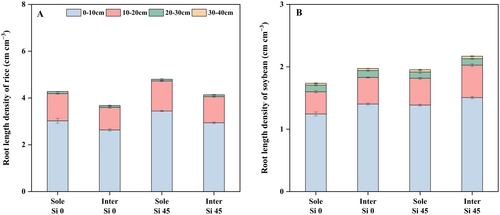
3.6 Correlations Between Plant Yield and Root Morphological Traits in the Field
Principal component analysis (PCA) was used to evaluate the relative contributions of the morphological traits, crop Si uptake, and soil physicochemical properties to crop yield, considering two Si levels and two cropping patterns (Figure 7). The results revealed that the first two axes of the PCA explained more than 80% of the total variance observed in rice and soybean (Figure 7). Correlation analysis demonstrated in parallel the correlation between yield, Si uptake, and crop root morphological traits, and soil physicochemical properties in rice and soybean (Figure 8). Among all the measured root morphological traits and soil physicochemical properties, the root surface area of both rice and soybean had the highest correlation with crop yield (Figure 7). Yield was significantly positively correlated with the root surface areas of both rice and soybean (Figure 8).
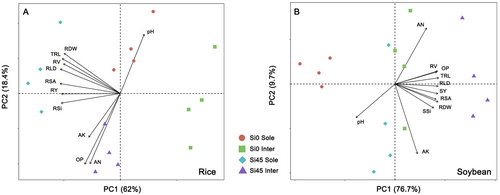
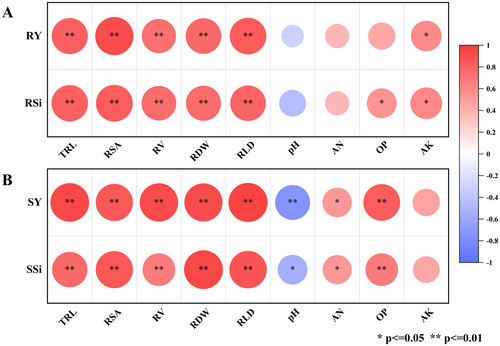
4 Discussion
4.1 Overyielding Advantages Associated With Dry-Cultivated Rice/Soybean Intercropping
Legume/cereal intercropping combinations play an important role in enhancing crop productivity in agroecological systems (Li et al. 2021; Ma et al. 2023). Consistent with the results of previous studies, our results showed that dry-cultivated rice/soybean intercropping effectively increased the overall system yield compared with the weighted means of monocultures, especially under 45 kg Si ha−1, leading to a greater total yield (Figures 1 and 2). The increased yield in the intercropping system is largely attributed to the complementary and competitive utilization of available resources throughout the growing season (Li et al. 2020). In this study, the yield advantages in the intercropping system were derived primarily from the positive CE in soybean to counteract the negative CE in rice (Figure 3). This finding indicates that although the overall yield of the intercropping system increases, it is largely due to the increased yield of the species with the highest yield within the intercropping system (Li et al. 2018). The relative increase in soybean yield (24%) in the intercropping system was greater than the decrease in rice yield (7%), leading to a positive CE of intercropped soybean (Figure 3). Thus, the minor reduction in rice yield was greatly offset by a significant increase in soybean yield, leading to a dramatic increase in the total yield of the rice/soybean intercropping system in both the field and the pot experiments, and the soybean was the dominant species in the rice/soybean intercropping system (Figures 1 and 2). Our findings are consistent with those of previous studies showing that a positive CE is the primary driver of increased yield in intercropping systems (Li et al. 2020; Mahmoud et al. 2022).
The positive CE of intercropped soybean increased the relative yield through the complementary utilization of resources both temporally and spatially (Figure 3, Figure S5; Sun et al. 2018; Yin et al. 2020; Wang et al. 2024). The growth and development dynamics of soybeans and rice differ; specifically, soybeans reach their flowering stage (July) earlier than the heading stage (August early) of dry-cultivated rice. This characteristic allows soybeans to occupy a superior ecological niche during their peak growth period, resulting in temporal differences in production (Zhou et al. 2019; Jiang et al. 2023). Moreover, intercropped soybean exhibited complementarity in the belowground spatial niche with rice, as evidenced by greater root growth along the soil profile in intercropped soybean than in rice (Figure 6). Giller (2015) reported that legumes can access water from deep soil profiles for longer periods, increasing dry matter production. Thus, spatial niche differentiation contributes to the increased yield of intercropped soybean (Nyawade et al. 2020; Ma et al. 2023). A similar response was reported by Sun, Gao, Yang, et al. (2019), who reported that legume/cereal intercropping can improve the yield of intercropped legumes through the complementary utilization of resources in maize/alfalfa intercropping systems. Furthermore, a few positive interspecific processes, including mycorrhizal networks, nodule fixation, and rhizosphere activation among species, might also have contributed to the complementary utilization of resources in legume/cereal intercropping systems (Qiao et al. 2016; Nyoki and Ndakidemi 2018; Wang, Gao, et al. 2020). Overall, these positive interspecific processes contribute to the positive CE of intercropped legumes, resulting in increased yields in legume/cereal intercropping systems.
In addition to interspecific complementarity, the performance of intercropping systems is also significantly affected by interspecific asymmetric competition between intercropped species (Yu et al. 2021; Wang et al. 2025). In the present study, the competitive ratio (CR) was > 1, indicating that, compared with rice, soybean had greater competitive ability in the intercropping system (Sun, Gao, Yang, et al. 2019; Figure 3). The lower PLER value for rice (< 0.5) and the higher PLER value for soybean (> 0.5) also confirmed the competitive disadvantage of rice and the advantage of soybean in the intercropping system (Figures 1 and 2). The relative yield advantage was consistently less than zero for rice and positive for soybean, further supporting this observation (Figure S5). Therefore, asymmetrical competition led to a yield decrease in intercropped dry-cultivated rice.
In our study, asymmetrical competition was primarily reflected in belowground competition, as demonstrated by the results of the root separation experiments in the pot experiments (Figure 5). The crop root system is the key site for belowground interactions between species (Lambers et al. 2006). Root morphology and spatial distribution are crucial for the foraging capacity of intercropping species and significantly impact composite crop yield (Sun, Gao, Yang, et al. 2019; Yu et al. 2021; Raza et al. 2021). Among all the root morphological characteristics in the present study, the root surface area was a key indicator of yield in intercropped crops (Figure 7). Our results revealed that intercropping led to an increase in the root surface area of the dominant species, that is, soybean, whereas that of rice decreased (Figures 4 and 5). Competitive species often present enhanced morphological characteristics that increase their forage capacity for nutrients and water (Zhang et al. 2012; Yu et al. 2021). Consequently, the yield of the weaker competitor (i.e., intercropped rice) decreased in the field, which was further confirmed by the biomass of rice in the pot experiment (Figures 1 and 2). Li et al. (2004) reported that the variation in total root length corresponds with yield variation and that the dominant species determines the overall yield in a maize/chickpea intercropping system. Asymmetric competition between species can also inhibit the root proliferation of intercropped disadvantaged species (Li et al. 2006; Gong et al. 2020). Thus, the shorter RLD of intercropped rice relative to that of monocultured rice was associated with reduced soil spatial effectiveness, which consequently contributed to a reduced yield of intercropped rice (Figures 1 and 6). In addition, adding exogenous fertilizers often leads to the accumulation of nutrients such as P in surface soils (Lynch 2011; Sun, Gao, Yang, et al. 2019). Therefore, increasing the RLD in surface soil is conducive to the absorption of nutrients and yield (Miguel et al. 2015; Sun, Gao, Yang, et al. 2019). Compared with that of monocultures, the RLD of intercropped rice decreased, whereas that of intercropped soybean increased in the 0–10 cm soil layer (Figure 6). This shift in root distribution affects the ability of crops to forage for nutrients and water in the soil, which in turn affects yield in the intercropping system (Figure 9; Li et al. 2006; Gong et al. 2020).

4.2 Effects of Si Application on Crop Yield Under Different Cropping Patterns
The present study revealed that Si application consistently increased crop yield and Si uptake, regardless of the cropping pattern used (Figure 1, Figure S6). A positive correlation between crop yield and root morphological traits has been confirmed by many studies (Sun, Gao, Wu, et al. 2019; An et al. 2023). In the present study, Si application increased the total root length, root surface area, root volume, and root dry weight of both the rice and soybean plants in both the field and the pot experiments (Figures 4 and 5). Similar responses have been reported by Fan et al. (2016) and Ashfaq et al. (2023), who reported that Si application resulted in greater root systems in terms of length, surface area, and volume than did the treatment without exogenous Si. The increase in root traits may be attributed to the beneficial effects of Si on photosynthetic efficiency and water relationships (Debona et al. 2017). The Si-induced increase in net photosynthesis might be due to the upregulation of the expression of key genes related to photosynthesis (Detmann et al. 2012). The increase in net photosynthesis may also be due to the increased leaf area and chlorophyll content resulting from Si application (Nyawade et al. 2020; Jiang et al. 2023). Furthermore, Si application improves water balance by increasing the ability of the root system to use soil moisture, which is crucial for meeting the demands created by evapotranspiration (Wasson et al. 2012; Lynch and Wojciechowski 2015). Si application may also affect leaf transpiration and enhance crop water use efficiency, leading to a relatively high net assimilation rate (Tripathi et al. 2021). Moreover, Si can increase the contents of plant lignin and phytohormones such as cytokinins, which contribute to plant stem and root growth, and improve plant resistance and nutrient transport capacity (Arif et al. 2021; Hussain, Mumtaz, et al. 2021; Hussain, Shuxian, et al. 2021). Si application can also increase crop yield through a series of physiological mechanisms (Debona et al. 2017; Meunier et al. 2017). For example, Si reduces the effect of unfavorable environments on plants by altering soil microbial communities (Song et al. 2021). Si optimizes crop uptake of nutrients such as nitrogen and regulates nutrient source versus storage (Ning et al. 2017; Jiang et al. 2023). Overall, Si application promoted aboveground and belowground plant growth (Figure 9).
Although our results clearly demonstrated that intercropping significantly increased the total yield of dry-cultivated rice/soybean intercropping systems, this increase was more pronounced with Si application (Figure 1). Several factors contribute to this observation. First, Si application increased the root surface area of both crops in the intercropping system, increasing nutrient and water uptake in both field and pot experiments (Figures 4 and 5; Ma et al. 2023). Second, Si application significantly lowers the canopy temperatures of intercropping systems, leading to reduced soil evaporation and increased soil water storage for intercropped crops (Nyawade et al. 2020). In addition, Si works in conjunction with N, P, and K to increase crop yield further in intercropping systems (Ning et al. 2017; Shen et al. 2019), as observed in our study (Table S2). Therefore, our findings support the hypothesis that Si application altered root morphology and distribution, which contributed to increased yields in dry-cultivated rice/soybean intercropping systems.
5 Conclusions
In the dry-cultivated rice/soybean intercropping system, the significant increase in soybean yield compensated for the decline in rice yield, resulting in a total yield that was greater than that of the monoculture. Si application significantly increased intercropped rice and soybean yields, resulting in a further increase in total intercrop yield. The increase in yield under intercropping was influenced by changes in the root morphology and distribution characteristics of the crops, with increased root surface area being the key to increased yields in rice and soybean. Si application promoted the expansion of the root systems of both crops in the intercropping system, significantly increasing the root length, root surface area, root volume, root dry weight, and root length density within the 0–20 cm soil layer of intercropped soybean and rice. This study filled a knowledge gap regarding Si application in rice/soybean intercropping systems, demonstrating that altering root morphology and distribution through Si application effectively enhances system productivity. However, the application of dry-cultivated rice/soybean intercropping is currently limited to the experimental scale. Further research is needed to evaluate the cost-effectiveness of this practice in agricultural production.
Acknowledgments
This work was financially supported by the National Natural Science Foundation of China (32301449), the Scientific Research Project of the Education Department of Jilin Province (JJKH20250564KJ) and the Jilin Science and Technology Development Plan Project (20240303024NC).
Conflicts of Interest
The authors declare no conflicts of interest.
Open Research
Data Availability Statement
The data that support the findings of this study are available from the corresponding author upon reasonable request.



